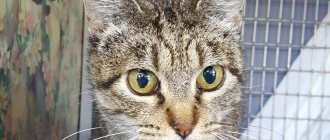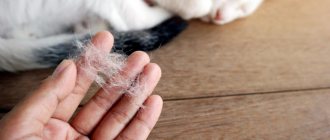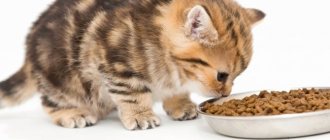Save the article:
To people who have not encountered the mating of animals, it may seem that this is a simple matter, that nature itself does everything, and the owners only bring a furry couple together. Well, professional breeders will disagree with this. mating cats and female cats will also disagree . Many questions immediately arise: you need to find out what time to knit and where is best, whether you need to prepare your pets, whether any documents are required.
It is better to study the answers to all the questions in detail and approach the matter fully armed.
When is the best time to breed cats?
global $ads_google; //data-ad-slot=”2475549904″ $ads_google = empty($ads_google) ? false : true; ?> if ($ads_google == false) {?>
$ads_google = true; ?> } ?>
Nature has its own time for everything. Mating of cats is carried out no earlier than one year: it is important to wait until they are fully physiologically formed. The first two heats are ignored.
The optimal time for mating for the first time is considered to be up to one and a half years old; if it is late, then there may be difficulties in communicating with the cat and the manifestation of strong aggression towards him.
An excellent solution would be to keep a diary with records of all the dates about the beginning and end of the estrus period: this will help calculate the beginning of the next estrus and set the day for mating the cat and the cat.
Cat in heat
Estrus does not last long: 5-10 days. In the first two days, a change in the pet’s behavior is noticeable. The female becomes agitated, overly affectionate, or unusually aggressive. The cat rubs against furniture and the legs of household members. The change in gait is obvious - one cannot help but notice the raised tail and arched lower back. The pussy still won't let the cat near it.
Then, until the 6th day, the owners “enjoy” the calling heart-rending meow. If you pet a cat, she immediately takes an unambiguous pose, not forgetting to move her tail to the side and raise her rump. Appetite decreases, urination becomes more frequent. The animal expresses its readiness to copulate.
Cat sexual maturity
The cat reaches sexual maturity from the 8th to the 10th month. It depends more on the breed. Puberty is completed by the age of one and a half years. There is a change in the behavior of the male: aggression appears, closer to night everyone “enjoys” the concerts of screams and meows. Particularly “pleasant” is the cat’s desire to mark everything around with a pungent-smelling secret. Particularly zealous cats make attempts to satisfy sexual needs with soft things. In the spring, the desire to continue their race is especially strong, although males are ready for this all year round.
Suitable age
The reproductive age of each dog is individual and depends on factors, the leading of which are:
- Floor.
- Breed.
- Dimensions.
- Heredity.
Puberty occurs quite early in most animals. In females, the first heat can occur as early as 6 months, and the male will be ready for mating at 9. However, the formation of the reproductive system does not mean that the dog is ready to give birth, and the dog has become a good producer.
Up to 1.5 -2 years, that is, before the dog reaches the size of an adult, the number of sperm in the seed is too small for high-quality fertilization to occur. In addition, it is necessary to wait until the testes have completely descended into the scrotum. Since at this stage, deficiencies that can be inherited are often identified.
If one of the testes does not descend from the abdominal cavity, the dog will not be given permission to reproduce. He may have offspring. But this defect is inherited, so it is removed from breeding. Age restrictions for females also have physiological grounds.
Therefore, the pet is allowed to fully mature. In addition, world canine organizations strictly limit the number of litters and the frequency of pregnancies. This is done for several reasons:
- Limit the number and prevalence of the breed so as not to oversaturate the market.
- Reduce the number of culled puppies born from mothers that are too young, too old, or who have not fully recovered.
- Preserve the health of dogs that need a period of rest after pregnancy, as this is a very difficult physical and psychological test for the body.
A feature that emphasizes the difference between the two sexes is also the age limit, which prohibits bitches over 8 years old from participating in breeding. At this time, boys can be active as much as their health allows.
Preparation for mating
Preparation is necessary to ensure that everything goes smoothly and without unnecessary problems. There are some tips for preparing cats and female cats for mating .
Owners of females should worry about searching for a male in advance, especially if they have purebred pets. In advance, before the start of the process, both parties prepare veterinary passports and documents confirming the origin and pedigree, and an agreement.
3-4 weeks before mating, the cat must be examined by a veterinarian; based on tests, he will issue a conclusion about the presence of infectious diseases; vaccination will also be carried out, if necessary.
Two weeks before the process, deworming is carried out. The animals' claws are trimmed within 2-3 days. The cat is not bathed to preserve its natural scent.
Second phase
You should not immediately try to pick up the cat, as this will most likely result in injuries - bites and scratches.
First, the cat is accustomed to your hand by placing it palm down on the floor; you can place the cat’s favorite toy nearby. You need to wait until the cat comes up and rubs itself on your arm or leg. In this way, she wants to make sure that the object present is not dangerous. If a person initiates contact, the animal may respond with an attack.
If the cat attacks, pick him up early
If the pet has given the go-ahead, the palm is slowly raised to eye level and held in this position for a while. Then they begin slow stroking. You need to stop before the cat gets tired of close contact with a person.
You should not drive away a cat if it climbs onto your lap, even when there is no time for tenderness. Then it will be more difficult to achieve such trusting behavior.
Mating contract
The contract is an important part that is simply stupid to ignore - it is a legal guarantee of honest cooperation between two animal owners.
The contract clearly states information about the animals, their owners and health status. Also, the obligations and rights of the parties are outlined point by point, all actions in case of various circumstances are regulated, the type of payment and its methods, management of pregnancy, responsibility for childbirth, and registration of offspring are also immediately indicated.
A cat mating agreement protects each party from possible problems, where clear instructions are given regarding all the nuances of the process.
Sample cat breeding contract.pdf
The cat's first mating
Despite the fact that a cat goes into heat for the first time at 7-9 months, a responsible owner will not rush to find a cat for her. The animal is not ready for mating, either physically or psychologically: this can lead to dire consequences in the form of complicated childbirth, stillbirth, and even provoke infertility. Starting from the age of one year, the cat is ready to try to continue her race for the first time.
global $ads_google; //data-ad-slot=”2475549904″ $ads_google = empty($ads_google) ? false : true; ?> if ($ads_google == false) {?>
$ads_google = true; ?> } ?>
The first mating is not much different from all subsequent ones: the bride is brought to the groom’s house, she gets used to it and after a while she lets her new friend come closer, sometimes she drives her away and lets her in again. Then the anger changes to mercy and a short sexual intercourse occurs. There can be up to 8 such acts within an hour.
Help from the owners
Mating is a natural process, but despite this, animals require the attention of their owners. And, in order not to wonder why the cat does not mate with the cat, mating should be controlled. Remember that this process requires maximum patience.
- Show you care. Do not rush your pets, do not push them towards each other - this will only aggravate the situation. The “newlyweds” must reach a certain stage themselves.
- Never raise your voice at your pets if you see that they are unable to come to an agreement. It is quite possible that they simply could not “agree.”
- If you see that potential partners have already moved on to a “showdown,” you can stop the meeting. There’s no point in expecting that they’ll get along anyway.
- If intimacy occurs, control the situation. The female may need your help if she begins to fall on her side, limiting access to her partner.
- After the successful completion of the “date,” carefully examine the female for wounds, since the male, in a fit of passion, may accidentally leave scratches on the cat.
How does mating occur in cats?
Although the cat is always ready for mating, the start of the process is scheduled for the 3-5th day of the female’s estrus. You should know that some breeds do not fall into this interval, since they ovulate on the 9-10th day.
The female is brought into the cat's territory - it is more difficult for him to do his job in an unfamiliar environment. The conditions specified in the contract are provided for the cat in the receiving home.
The cat gradually gets used to it and can begin to flirt with the male. This behavior of a lady signals to her partner that it is time to get closer. At the first attempt, the shrew can hit the male with her paw, and he retreats. After several attempts by the groom, the kitties stop reacting like that, and he mounts. Half a minute later, the cat’s contented purring and loud cries are heard.
The eggs are released from the ovaries and fertilization occurs.
Briefly about puberty
It is an open secret that the onset of puberty in a cat occurs earlier than the onset of physiological maturity. Puberty means the female’s readiness to bear offspring, and the male’s readiness to fertilize the cat’s egg. As for females, they become sexually mature after about six months from birth. This does not mean that after six months it would be worth looking for a cat and getting a couple together. Early pregnancy may have some not very pleasant consequences:
- slowdown in cat development;
- a weak offspring may be born;
- the vlomyak cat will endure the pregnancy period;
- this may be the only pregnancy.
From time to time the female will “flow”, the best option would be to start looking for a suitable sire. And it’s a matter of stopping at two or three males, from which over time you can choose one.
Males are allowed to talk about puberty when they are eight months old. At this time, castration is allowed, but it is too early to think about mating the cat. Males can also have negative consequences due to early mating, including:
- rallentando of the growth process;
- deterioration in appearance;
- risk of impotence.
Due to this, when breeding animals after they reach puberty, you only need to wait a little.
When to pick up an animal
If after mating the cat turns over on her back and starts rolling on the floor, and the cat leaves and indifferently licks her genitals, the mating cycle is over. But the lady is not immediately taken away from her gentleman.
For the entire period from the moment the cat arrives at the house of the future father of her children until the end of the mating period, 4-5 days can pass. But if the lady quickly gets used to it, and the partners accept each other, two or three days are enough for everything. After this, the owner of the male notifies the other party about the completion of the process, and the future mother of the charming kittens can be taken away.
Cat behavior after mating
It is interesting to observe how the owner’s pet behaves after the end of the process - impatient owners want to quickly understand whether their cat is pregnant?
In the first days after mating, the pussy may continue to ask the cat, scream and seem restless: even if everything was successful, the body does not rebuild itself in a day, and hormones continue to play in the pet’s blood for some time. This will pass in 2-3 days.
Sometimes after the beauty is brought home, she hides in a corner and is sad, sleeping a lot. The lethargy of the expectant mother is explained by fatigue from the stress she has experienced and the estrus itself.
It happens that a cat refuses food for several days, only drinking water - this is simply the consequences of stress.
We deliver babies
There are three stages of childbirth. The developing fetuses, protected by the amniotic membrane, are attached to the wall of the uterus by the placenta, and are located in the horns of the uterus, which in a cat is bicornuate. The horns, at the point of their connection, pass into the uterine canal, which passes through the cervix into the vagina, and it, through the vestibule of the vagina, into the vulva. All these structures together are the cat’s birth canal. During the course of labor, three periods can be roughly distinguished. In the first period, the cervix dilates and the birth canal opens, in the second, kittens are born, and in the third, the placenta comes out.
The first stage of labor can last from 12 to 24 hours and in the initial stage it can be almost unnoticeable. And it all begins with chaotic, voluntary contractions of the uterus (pushing), during which the cat’s breathing quickens and she purrs to the beat. These contractions are at first rare and weak, looking like peristaltic waves from the top of the uterine horn to its body. The uterine horns contract alternately, gradually pushing the fetuses into the uterus.
The vagina swells a little a few hours before contractions, and a thick sticky discharge of a transparent, yellowish or bloody color appears from it. At this time, the cat becomes restless, licks the vulva (loop), strains as if during defecation, meows pitifully, and rakes up the bedding.
As the labor process progresses, contractions become more frequent and their duration increases, while the pain intensifies. During contractions (i.e. contractions of the uterus), the fetus is pushed further towards the cervix, and it dilates. And when the abdominal muscles begin to contract and the fetus moves into the vagina, the birth process is in full swing. At this time, a cat giving birth for the first time can be extremely frightened, and then she screams pitifully and seeks help from the owner, who must constantly reassure her by talking to her and caressing her.
During contractions, intrauterine pressure increases and the vascular membrane (chorion) ruptures. The amnion (water membrane) and allantois (urinary membrane), filled with fluid, are introduced into the cervix, expanding its canal like a hydraulic wedge. From this moment on, the cervix, uterus and vagina form one wide birth canal. During the formation of the birth canal, the presentation and articulation of the fetus is established for its exit from the uterine horn.
Gradually, pushing joins the contractions. They are caused reflexively, as a result of irritation of the nervous elements in the tissues of the cervix and pelvic walls by the presenting parts of the fetus. If you put your hand on the female's belly while pushing, you can feel it hardening. The pain continues to intensify, causing the cat to meow more and more pitifully and breathe frequently (like dogs in the heat). In between attempts she relaxes. Under the influence of contractions, supported by pushing, the fetus passes deeper and deeper through the birth canal. Gradually moving forward, the kitten comes out into the pelvis, and then is forcefully pushed further towards the exit from the vagina, passing part of the way with a strong contraction.
Second stage of labor
Usually on this section of the path the strength of the contractions is greatest. The water sac (amnion) surrounding the fetus appears between the labia of the vulva, ruptures, and a straw-colored fluid flows out. This is the release of amniotic fluid. Amniotic fluid lubricates the passage, facilitating the advancement of the fetus. Finally, part of the kitten (paw, head, tail) appears from the loop, appearing and then disappearing again.
As a rule, at this moment the cat relaxes and rests to gather strength. In classic cases, the cat makes two strong attempts at once and expels the kitten, connected by the umbilical cord to the afterbirth. The kitten is born with or without the membrane. About 70% of kittens are born in the "diver" position - with their forelimbs and nose first. The cat independently processes the baby, gnawing the membranes (if any), intensively licking the kitten's face, cleaning its nose, mouth and body, thereby stimulating its breathing and blood circulation, causes the first separation of feces, after which it gnaws the umbilical cord. The kitten takes a sharp breath, its lungs expand, and it begins to breathe.
Maternal instinct is a very important connection. The cat understands that this is her “baby” and she is obliged to take care of him. Sometimes from the outside it seems that she does everything rudely, but in fact she stimulates the cub’s breathing and blood circulation. The cat rests for some time after the birth of a kitten, then contractions and pushing resume, and the next kittens are born. Most cats kitten at intervals of 15 minutes to an hour. Two or three kittens may be born one after the other, but the next ones can be expected within another 3-4 hours, and sometimes longer. If a cat who is handling another kitten forgets to remove the amniotic sac, you must do it for her very quickly, otherwise the kitten will suffocate.
Third stage of labor
The separation of the placenta (baby place) is noted, which comes out a few minutes after the birth of each kitten. The mother will try to eat some or all of the placentas. This is a purely instinctive reaction, which may have been preserved from those ancient times when the animal had to strengthen its strength and destroy all traces of childbirth in order to save its offspring. However, she may not do this. Eating afterbirth leads to a laxative effect, that is, diarrhea. You can limit the amount of afterbirth she eats or let her eat them all.
Cats chew the umbilical cord, grinding it (in this case, the blood vessels are twisted and overstretched, and bleeding does not occur). If it is crossed too smoothly or too close to the navel, bleeding occurs. The umbilical cord should be compressed, tied with thread and cauterized with iodine or some other suitable antiseptic. It is important not to tighten the umbilical cord too much, so as not to provoke a hernia. Once some or all of the kittens have been born, the cat lies on her side and pushes them towards her nipples. Sucking kittens stimulates uterine contractions and the secretion of colostrum (mother's first milk), which contains all the necessary maternal antibodies.
Sometimes childbirth seems to stop, the Cat calms down and takes care of the kittens. Then, after 12-24 hours, labor resumes and the cat gives birth to the rest of her kittens. This is absolutely normal and there is no need to worry unnecessarily. There are no identical births; all cases are individual. It is quite difficult for a breeder with no experience to determine the boundary between the norm and the anomaly. It happens that a cat that has given birth to 3-4 litters without any problems suddenly develops complications during subsequent births and has to undergo a caesarean section. And vice versa.











